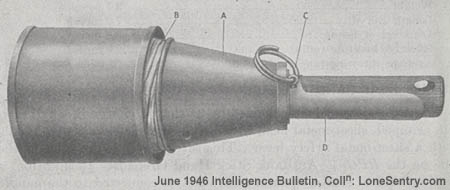Panzerwurfmine - a German antitank hand grenade
Quoted from: http://www.lonesentry.com/articles/panzerwurfmine/index.html
An antitank hand grenade has been developed by the Germans for use by infantry troops in close combat against tanks. Known as the Panzerwurfmine, this weapon is capable of penetrating 3 inches of homogeneous armor plate, and may be thrown as easily as an ordinary stick grenade.
The Panzerwurfmine, which weighs about 3 pounds, consists of a cone-shaped body with a hemispherical end, and with the stick handle attached to the other, or point, end of the cone. The most novel feature of this weapon is a set of four collapsible cloth vanes which are folded against the handle. When the grenade is thrown, the vanes spring open and presumably guide the projectile head-on to the target.
The conical head of the grenade is filled with a hollow charge designed to direct the force of explosion in one direction—against the armor plate of the target. Built to detonate on impact, the grenade fuze is located in the butt end of the hollow wooden handle, which is filled with an explosive booster charge. The fuze—a striker pin held back from a primer cap by a weak spring—detonates when the force of impact overcomes the weight of the spring and throws the striker against the cap. A safety pin which fits into the top of the fuze assembly keeps the fuze in an unarmed condition until the grenade is thrown. The fuze assembly is housed in a thin metal cylinder fitted over the end of the wooden handle.

The grenade is armed in flight when the loosely seated safety pin is pulled free by the drag of air on a short cloth tape, one end of which is fastened to the free end of the pin.
Near the cone end of the handle, four spring steel ribs are secured in grooves. When extended, umbrella-fashion, these ribs are the framework for the cloth vanes. When the vanes are collapsed, the ribs are held under tension flat against the handle, and are secured in position by a metal cap which fits over the end of the fuze assembly and the free ends of the folded ribs. This cap is held in place by a metal tongue on the fuze assembly. The tongue passes through a slit in the cover.
During transport the tape attached to the safety pin is secured under a horseshoe-shaped metal clip which snaps around the outside of the fuze assembly, thus holding the safety pin in place. A short piece of string is tied from the clip to the end of one of the folded steel ribs.
Although the Panzerwurfmine may seem easy to use, it requires a degree of caution upon the part of the thrower, who must be sure that the vanes remain closed—thus keeping the grenade unarmed—until the weapon leaves his hand.



Quite interesting, isn’t it? I never heard or read before about this “weapon”. 


